This website uses cookies so that we can provide you with the best user experience possible. Cookie information is stored in your browser and performs functions such as recognising you when you return to our website and helping our team to understand which sections of the website you find most interesting and useful.
The different Kites
Kites, also known as umbrellas or kites, are available in various designs, which differ, among other things, in their attack surface and the angle of attack of the wind.
The kite can be controlled using lines to vary the direction and strength of the forces acting on the athlete.
The size of the kite used is mainly chosen depending on the wind strength.
Stronger winds require smaller umbrellas to avoid overloading.
Beginners in particular should be careful not to use a kite that is too large. It should be noted that doubling the wind speed can result in a quadrupling of the forces in the kite, which can have dramatic consequences in the event of incorrect steering movements. For example, a 9 m² kite can easily pull two adult men out of the water in a wind force of 6.
In order to reduce the forces that occur, the kites are equipped with a so-called “depower” function. By using “Depower” the angle of attack of the kite’s leading edge to the wind is reduced and the profile of the wing is changed, resulting in less wind being caught in the wing and the pull of the kite decreasing.
A main distinction is made between soft kites and tube kites:
There are basically three basic shapes
C-Kite, Bowkite and Delta-Kite. But now mainly hybrid kites are produced, which are a mix of two or three variants, such as the Delta-Bow, the C-Bow or the Open-C Delta Hybrid. Why it is like that? Well, over time it was discovered that each of them has advantages and disadvantages, and the hybrid forms made the kites not only a little more dynamic, but also more suitable for specific uses – there are now wave kites, freestyle kites, All-rounders and, for example, kites that are called loop machines. Ultimately, however, it is purely a matter of taste!
It all started with two-line soft kites without a trapeze – those were exciting times! Then the depower system was invented and the tube kites were developed
These were the very first C-kites. Initially they had four lines, which meant retrieving you had to swim to the kite to position it correctly before you could launch it again. You can imagine what effort that was!
At some point a fifth line was integrated into the middle, allowing the kite to be properly positioned simply by pulling it, and the side lines ensured that the kite could be brought closer to the wind window for relaunch.
Finally, it was found that the C-kites are not as dynamic and are difficult to launch in low winds. This is how the bowkites came about! They are significantly more dynamic and have slightly more pointed ends so that there is not as much surface area on the water, which makes retrieving them much easier as the kite can be brought more easily to the wind window with less resistance. The Bowkites then no longer needed a fifth line, but they were quite unstable in strong winds and the stress at the pressure point was felt strongly on the bar. It was similar with the Delta kites.
Therefore, hybrids began to be produced in all variants, and this resulted in different areas of application. Every brand now has a freestyle kite, a wave kite, an all-round kite and so on. But to understand why a kite is better suited for one discipline than another, we need to take a closer look at the shapes of kites and their aspects.
What are the differences between the different forms
The shape of a kite is made up of three components: the profile (i.e. the cross section), which can be either flat or steep; the curve cap (the view from the front), where a very round curve cap is typical for C-kites; and the outline or aspect ratio (viewed from above). The aspect ratio is the ratio of depth to width of a kite.
To explain: the flatter the design of the kite, the larger the aspect ratio, and the rounder it is, the smaller it is. The outline of C-kites is rather low cut, which means they have a lower aspect ratio. Aspect Ratio is probably the most important factor in assessing what a kite can do, especially for beginners.
There is also talk about low-end and high-end kites. Low-end means that the kite can develop a lot of pulling power in little wind. A good high-end kite is one that produces little traction in high winds. These are two completely opposite characteristics, meaning a kite cannot have both. If a kite has a good high end, then the low end is worse. So the designer has to sacrifice one to enhance the other. The freeride kites are somewhere in the middle and differ in a better high-end or low-end – and each shape has its place.
How are kites different from each other?
The differences between the kites relate, among other things, to their upwind properties, the lift, the hang time and the drift. Let’s take a closer look at the different types:
Freeride kites are the most all-round kites. They usually have a medium aspect ratio, meaning they are neither too flat nor too curvy, allowing them to launch well even in low winds. A curvy kite is more difficult to launch because there is more material hanging in the wind window. A flatter design can be placed closer to the wind window and is therefore easier to maneuver when starting. The freeride kites are right in the middle in this regard. It is also said that they are more direct because they develop a lot of pull when turning, in contrast to the C-kites.
A C-kite, when turned in, spins and then accelerates into the wind window, resulting in a powerful pull! C-kites are considered freestyle kites because they offer reliable lift when jumping but have little hang time. This means that they shoot you up well, but also let you fall down quickly. Therefore, they require quick maneuvers during air rotations. In addition, C-kites tend to have poorer upwind properties and are therefore not the easiest kites to learn to kitesurf!
The type of drift
that C-kites provide is also not ideal for riding in waves. If you are in the wave with a C-kite and want to loop your kite before the wave hits you, you have to react really quickly to get out in time. For waves there is the famous FOne Bandit Open-C Delta Hybrid. As the name suggests, the Bandit is not so curved, but rather open, which makes the kite much more all-round suitable than the classic C-kite. They are fast, direct and have a good drift.
Overview kite design parameters
Parameter description
Angle of attack
Angle of attack of the profile in the center relative to the flowing air.
Changes constantly in flight. If the angle of attack is too large, a backstall occurs.
If the angle of attack is too small, frontal stall occurs.
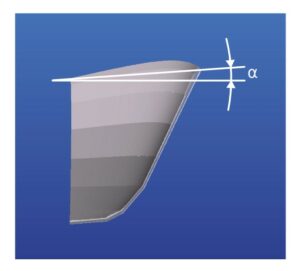
Backward sweep of the leading edge
Angle relative to the vertical in which the leading edge is swept backwards.
The angle changes in flight along with the angle of attack.
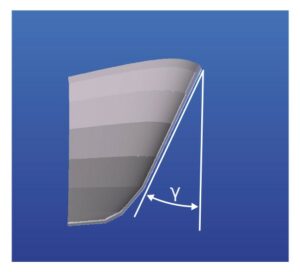
Nose angle
Angle between the angle of attack and the sweep back of the leading edge.
The angle is permanently installed and largely determines the flight characteristics of the kite.
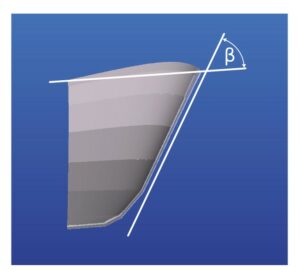
Wingspan (projected)
Wingspan (Sp) of the kite in flight.
Due to the round shape of the leading edge, the projected wingspan is significantly smaller than the length of the laid out kite.
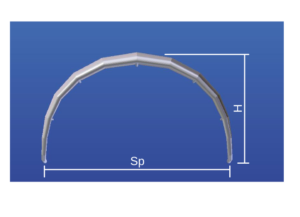
Stretching
The aspect ratio indicates how “stretched” a wing is.
It is defined as the ratio of the square of the wingspan to the wing area.
A higher aspect ratio reduces the induced drag at high lift coefficients.
Altitude
Height (H) of the kite when inflated.
High to Span Radio
Quotient of height and projected span.
Neutral point
At the neutral point, the torque about the transverse axis remains approximately the same when the angle of attack changes.
The neutral point depends only on the plan of the wing surface.
Center of gravity
The center of gravity is the center of mass of the kite and is determined by the weights of the materials used and the associated levers.
Stability measure
The stability measure is the ratio of the distance between the neutral point and the center of gravity to the total wing depth.
It indicates how stable the kite is when there is no tension on the lines around the transverse axis.
The stability measure is crucial for the drift behavior.
Diameter of the leading edge
Diameter and change in diameter of the leading edge from center to tip.
Pointing – Chord
Ratio of the tread depths at the tip and in the center to each other.
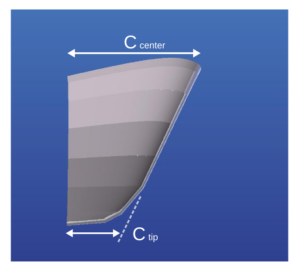
Profile thickness
Thickness of the profile and change in profile thickness from the center to the tip.
Overview of kite designs
All information is relative and refers to the other kite designs described. Exact angles and ratios can be found in the 3D models.
In principle, it is not possible to divide all kites into fixed categories. Every designer has his or her own ideas about a kite and designs it accordingly. The result can then be an “all-rounder” that fits into several categories.
The selected categories are therefore only to be understood as a guide; the transitions are fluid.
The 3D models of the kites shown and used are for illustrative purposes only. They are not suitable for reproduction.
For a direct comparison, all kites shown are shown with the same sail area (approx. 8.5 square meters) and the same angle of attack in the center.
Some properties are shown visually in the side view. A rectangle corresponds to a length of 10cm.
Source and Pictures: www.wingworks.de

